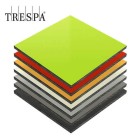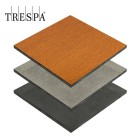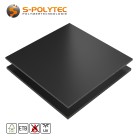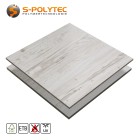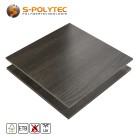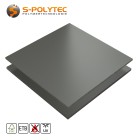
HPL sheets in custom cut
Our HPL sheets are available in different colours and in 6mm or 8mm thickness. HPL sheets are weatherproof compact sheets made of high-pressure laminate, whose high quality is not affected by the weather.
- HPL sheets are UV- an weather resist ans suitable for indoor and outdoor use
- HPL sheets withstand even the most adverse climatic conditions (for example deep frost or acid rain)
- HPL sheets are extremely rigid, scratch-resistant and impact-resistant
Trespa® Meteon® FR UNI COLOURS 2x1meter
 from €271.50 / pcs
from €271.50 / pcsIncl. 19% Tax
Trespa® Meteon® FR WOOD DECORS 2x1meter
 from €271.50 / pcs
from €271.50 / pcsIncl. 19% Tax
Trespa® Meteon® FR NATURALS 2x1meter
 from €334.15 / pcs
from €334.15 / pcsIncl. 19% Tax
HPL sheets anthracite (RAL7016)
 from €62.16 / m2
from €62.16 / m2Incl. 19% Tax
HPL sheets vintage look (oak white)
 from €74.11 / m2
from €74.11 / m2Incl. 19% Tax
HPL sheets wood decor (dark ash)
 from €74.11 / m2
from €74.11 / m2Incl. 19% Tax
HPL panels dusty grey (RAL7037)
 from €62.16 / m2
from €62.16 / m2Incl. 19% Tax
HPL sheets light grey (RAL7035)
 from €62.16 / m2
from €62.16 / m2Incl. 19% Tax
HPL panels jet black (RAL9005)
 from €62.16 / m2
from €62.16 / m2Incl. 19% Tax
HPL sheets traffic white (RAL9016)
 from €62.16 / m2
from €62.16 / m2Incl. 19% Tax
HPL sheets silver gray
 from €62.16 / m2
from €62.16 / m2Incl. 19% Tax
VHM facade panel drill
 from €39.27 / m2
from €39.27 / m2Incl. 19% Tax
Buy weatherproof HPL sheets cut to size mega-cheap online
Weatherproof HPL sheets from S-Polytec - cut to size to the millimeter
Buy HPL sheets made to measure - This is how it works
All HPL panels from S-Polytec can be conveniently ordered online in millimetre-precise cuts. Simply select the desired panel by clicking on the Calculate price button to go to the product description of the HPL panel. Select your desired panel thickness from the available thicknesses and enter the required dimensions in millimetres (not centimetres). The price calculation is immediate and automatically takes quantity discounts into account depending on the total weight of your specifications.
Cutting is usually done on the next working day on one of our modern panel saws. Thanks to state-of-the-art computer control, very low tolerances of only +/- 1mm are possible for the length and width of your blanks. The use of special saw blades with pre-scoring function guarantees flawless, perfect cut edges without chipping or splintering.
HPL cuts unbeatably cheap
As a specialist dealer, we offer HPL sheets cut to size at unbeatable prices without compromising on quality. We buy HPL plastics in very large quantities. This enables us to obtain attractive purchasing conditions. Another advantage is that we always keep correspondingly large quantities in stock at our two production facilities. This guarantees fast delivery times for your blanks. Sophisticated cutting optimisation means that even the smallest off-cuts can still be used efficiently for sales and therefore do not have to be disposed of. This also has an effect on the very favourable price for our HPL sheets.
Our standard delivery programme for HPL sheets
- HPL panels cut to size in 6mm and 8mm thickness in anthracite with ETB fall protection (flame retardant)
- HPL panels cut to size in 6mm and 8mm thickness in silver grey with ETB fall protection (flame retardant)
- HPL panels cut to size in 6mm and 8mm thickness in white with ETB fall protection (flame retardant)
Our extended delivery programme on request
- HPL sheets in standard format 4200x1620mm with 6mm thickness in white, silver grey, medium grey, anthracite, champagne and terracotta
- HPL sheets in standard format 4200x1620mm with 8mm thickness in white, silver-grey and terracotta
- HPL sheets in standard format 2100x1860mm with 6mm thickness in white, silver grey, medium grey, anthracite, champagne and terracotta
- HPL sheets in standard format 2100x1860mm with 8mm thickness in white, silver-grey and terracotta
- HPL sheets in standard format 4200x1860mm with 6mm thickness in white, silver grey, medium grey, anthracite, champagne and terracotta
- HPL sheets in standard format 4200x1860mm with 8mm thickness in white, silver grey and terracotta
Note: All HPL sheets in standard format can also be supplied cut to size on request. Our friendly advisory team will be happy to inform you about delivery times and conditions.
Individual milled parts from HPL sheets
In our online shop, it is currently only possible to configure and order HPL blanks in rectangular format. With our milling service, however, we offer you far more possibilities, so that individual shapes can also be milled from HPL. Thanks to modern CNC milling machines with three axes, we can also mill recesses, engravings or cut-outs. Hole drilling for easy mounting of your HPL panels can also be easily implemented with our milling service.
For specific enquiries regarding milled parts made of HPL plastic, our sales staff is always at your disposal. Simply send us an e-mail with a drawing of your milled parts and state the desired quantity, thickness and the desired decor of the HPL sheets. We will send you an individual offer including shipping costs as soon as possible. The quotation is of course free of charge.
Delivery & packaging of your HPL sheets
Depending on the size and total weight of your order, your HPL sheets will be delivered either as a parcel by a parcel service provider or on a pallet by a freight forwarder. The delivery of your order usually takes 2 - 3 working days from receipt of order. Delivery with the selected shipping service provider usually takes a further 1 - 2 working days.
Before shipping, all blanks are checked for quality of the sawn edge and compliance with the ordered dimensions and securely packed. Only fully recyclable material is used for packaging.
Note: HPL panels are extremely scratch-resistant and are therefore sometimes delivered without a protective film. To avoid damage to the top layer, please ensure that the boards are not pushed over each other or pulled over an edge when working and processing. Whether the boards are provided with a protective film is listed in the product description.
HPL sheets in use
Sheets made of HPL plastic are extremely versatile due to their weatherproof properties. The laminate panels are waterproof, UV and weather resistant and are extremely easy to clean. In addition, the solid sheets are scratch-resistant and extremely stable.
In the building industry, the panels made of high-pressure laminate are mainly used for cladding the facades of properties or as privacy screens for balconies. In interior design, the rigid panels are very often used as partitions and decorative cladding for interior walls. Hardly any public building can do without HPL panels. Take a look at the toilet areas in the next restaurant and you will see that the toilet cabins and doors are mostly made of HPL plastic. In gardening and landscaping, the weatherproof panels are used as privacy fence elements. But the panels are also often used as garden sheds, tool sheds or as cladding for rubbish container shelters.
Typical examples for the use of HPL panels
- As a facade panel for large-area facade cladding outdoors
- As an opaque privacy screen for balcony edging or balcony partitions
- As a room divider in offices, changing rooms or WC areas in restaurants
- In the garden as a privacy fence or for a weatherproof summer house
- and many more
What is HPL plastic?
HPL plastic consists of paper and wood fibres as well as resins that are pressed into a solid board and are considered particularly environmentally friendly due to their natural, renewable raw materials.
During production, several layers of kraft paper made from recyclable raw materials are soaked in melamine resin. These form the basis of the solid, hard board. The number of layers determines the final thickness of the boards. The top layers consist of one or more layers of decorative paper in the corresponding colours or decors in which the laminate panels are offered on the market. These are also soaked in resin and then pressed together under very high pressure and heat to form a solid, solid board. This is where the name comes from, which stands for High-Pressure-Laminates (high-pressure laminate).
Physical properties of HP plastic
HPL panels are usually used as facade panels for exterior cladding. This is possible without hesitation, as the sheets are naturally UV-resistant and can withstand even adverse environmental influences such as acid rain permanently. They absorb almost no moisture from the environment and are therefore considered waterproof. This is also one reason why the decorative tiles are very often used in wet rooms such as public toilets.
The very high bending stiffness of the panels, especially in the case of HPL panels with balcony approval according to the ETB guideline, are further positive properties of the panels. They can thus also be used as privacy screens for balconies or as partition walls indoors.
Depending on the area of application, the use of flame-retardant facade panels may be necessary. This is particularly the case when used on or in publicly accessible buildings. Not all HPL panels meet this requirement, but there are also types that are classified as flame-retardant according to DIN EN 13501 B-s2,d0 (comparable to DIN 4102 B1).
- Physical density: 1.35 g/cm³ (depending on version)
- Application temperatures: -30 °C to +80 °C
- Fire behaviour: DIN EN 13501 B-s2,d0 (flame retardant)
- UV resistance: Yes
- Weather resistance: Yes
- Water resistance: Yes
- Food conform: Physiologically harmless according to BfR (depending on design)
Note: For detailed information on the physical properties of our HPL sheets, please refer to the respective product description and the associated data sheets, as the specifications of the sheets may differ depending on the design.
Processing of HPL sheets
HPL cutting
HPL panels can be easily cut to the desired size by sawing or milling. Due to their high hardness, HPL plastics can in principle be processed like hardwood. For sawing, we recommend using a carbide saw blade with alternating teeth. Depending on the thickness, the feed rate should be selected at around 6 - 9 metres per minute. We even use two saw blades at the same time when cutting our HPL sheets. One for pre-scoring for a perfect sawn edge on the underside, and one with a high projection for an impeccable cut edge on the top side.
In order to mill individual shapes or cut-outs, milling cutters made of tungsten carbide have proven themselves with us (e.g. tungsten carbide spiral plate milling cutters for chamfering edges).
TIP: Buy your HPL panels directly cut to size conveniently online at best prices in our shop.
HPL Drilling
For installation as facade cladding with HPL screws, holes must be drilled in advance. This can be done with a conventional hand drill at medium speed (without percussion drilling function). However, HPL plastics have a very hard surface, so a drill made of hard metal (HSS drill) must be used here. To prevent the drill from slipping, the holes should be punched with a centre punch beforehand. When drilling with a hand drill, the panels should lie completely on a smooth, flat surface. This reduces the risk of chipping and chipping on the back when the drill comes out.
With a solid carbide facade panel drill (solid carbide drill with centre point), hole drilling can be carried out even without a firm base. Due to the special design of the drill, which was specially developed for drilling facade panels with high surface hardness, chipping is not to be expected during freehand drilling.
TIP: With our milling service, we can deliver your HPL sheets cut and drilled - inexpensively and quickly.
HPL assembly
HPL panels are often used as facade panels or balcony screens. For the installation of the panels, a substructure made of metal or wood is usually erected, to which the panels are screwed. Depending on the type of substructure, HPL screws in the appropriate colour are used. These are usually available with a coarse thread for wood in various strengths and lengths, but also with a metric fine thread for metal in various designs. HPL panels can also be mounted on a metal substructure with aluminium or steel rivets. It should be noted that HPL expands when exposed to heat and therefore one hole must be selected as a fixed point. The other hole drillings are to be seen as sliding points, so that these should have some play for expansion when fastening. Otherwise, HPL panels can warp due to the effect of heat.
TIP: We have written a Do-it-yourself guide to installing a balcony surround for you on the blog.
HPL Bonding
To bond HPL, an adhesive with very high adhesive strength and equally high initial adhesion is required, because HPL panels are very heavy compared to other plastic panels. With an MS polymer such as our Parabond 600, the panels can be bonded very well to almost all substrates (e.g. concrete, sand-lime brick, metal, wood, etc.). MS polymers require humidity to cure. To glue an HPL panel, apply the adhesive in waves at intervals of about 10 - 15 cm to ensure that air can get between the panel and the substrate. Then place the board under pressure in the desired position. The glued panel should be secured against slipping or falling down for about 24 hours until the MS polymer has cured.
Environmental Compatibility of HPL Plastics
HPL panels are considered particularly environmentally friendly because they can be fully recycled and are made from renewable raw materials. Depending on the manufacturer and design, recycled paper is also used for the kraft paper during production.
Recycling of HPL sheets
Recycling of HPL plastics
Since the multi-layered facade panels are a fully recyclable product made of paper and wood fibres, they are often finely ground up to be used as a filler, for example for thermal insulation in the construction industry. In a waste incineration plant, disposed HPL panels can be used to generate energy. In this way, part of the energy that has to be used for the production of the multi-layered high-pressure panels can be recovered. This requires high temperatures, so we strongly advise against burning them in the fireplace at home.
Disposal of HPL plastics
Offcuts from HPL, as well as smaller panels that are no longer to be used, can be disposed of with household waste without hesitation. Larger formats and quantities can be disposed of at the recycling centre without any problems.
